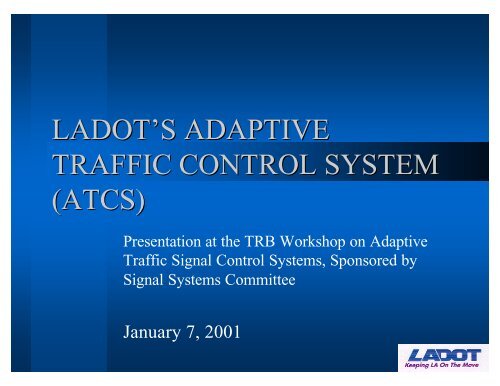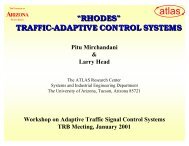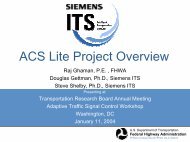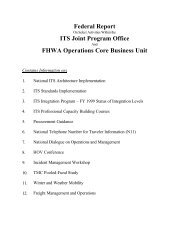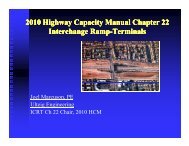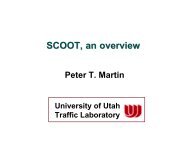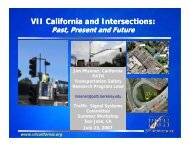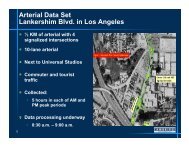ladot's adaptive traffic control system (atcs) - Traffic Signal Systems ...
ladot's adaptive traffic control system (atcs) - Traffic Signal Systems ...
ladot's adaptive traffic control system (atcs) - Traffic Signal Systems ...
You also want an ePaper? Increase the reach of your titles
YUMPU automatically turns print PDFs into web optimized ePapers that Google loves.
LADOT’S ADAPTIVE<br />
TRAFFIC CONTROL SYSTEM<br />
(ATCS)<br />
Presentation at the TRB Workshop on Adaptive<br />
<strong>Traffic</strong> <strong>Signal</strong> Control <strong>Systems</strong>, Sponsored by<br />
<strong>Signal</strong> <strong>Systems</strong> Committee<br />
January 7, 2001
GENERAL DESCRIPTION<br />
• PC-based real-time <strong>adaptive</strong> <strong>traffic</strong> <strong>control</strong> <strong>system</strong><br />
• Developed by LADOT staff<br />
• UTCS database and Operator Interface Language<br />
(OIL)<br />
• Window NT with real-time extension<br />
• Distributed client-server architecture<br />
• Prototype <strong>system</strong> was operational in 1996. PC<br />
Window based <strong>system</strong> was completed in 1999.<br />
• Currently 375 intersections on-line in three<br />
<strong>system</strong>s
WORKSTATION DISPLAY
DYNAMIC AREA MAP
DYNAMIC INTERSECTION MAP
GUI-<strong>Signal</strong> Timing Parameters
GUI-Adaptive Parameters
CONTROL STRATEGIES<br />
• Calculations of Cycle Length, Splits and Offset<br />
are three separate but dependent functions<br />
• Volume and occupancy data are collected every<br />
second, but used every cycle<br />
• Apply heuristic formulas based on extensive<br />
operational experience<br />
• Use critical link/intersection approach<br />
• Include a <strong>traffic</strong> projection module<br />
• Parameters can be easily adjusted to adapt to<br />
different street configurations<br />
• Transit priority <strong>system</strong>
TRANSIT PRIORITY SYSTEM
SYSTEM ARCHITECTURE<br />
• Centralized area computers (PC Server)<br />
communicate to local <strong>control</strong>lers.<br />
• Multi-port serial cards connect to<br />
communication lines.<br />
• GUI Client running on area computers and<br />
workstations.<br />
• Main Data Server provides central <strong>traffic</strong><br />
data base and coordinates area<br />
computers.
COMMUNICATIONS SYSTEM<br />
• Dedicated communication path between<br />
host and local <strong>control</strong>lers<br />
• Time division multiplexing<br />
• Local <strong>control</strong>lers polled once per second<br />
at 1200 bps<br />
• Four intersections per communication<br />
line.<br />
• Multiple communication protocols<br />
• Download/Upload to local <strong>control</strong>lers
CENTRAL HARDWARE REQUIREMENTS<br />
• Rack mounted server with a backup PC.<br />
– 350 MHz PC with 192 MB RAM<br />
• Workstation with two 21-inch monitors.<br />
• Multi-port PCI serial cards.<br />
• Ethernet network.
WHY ADAPTIVE<br />
• Needs to update timing plans<br />
• Basic 3 timing plans (AM, MD and<br />
PM) are not sufficient<br />
• Incident management<br />
• Special events<br />
• Already has extensive detection<br />
<strong>system</strong><br />
• Land development initiatives
HOW MANY SIGNALS <br />
• A total of 375 signals in three separate<br />
<strong>system</strong>s:<br />
– Mar Vista area: 99 signals<br />
– South Park area: 109 signals<br />
– Boyle Heights area: 167 signals<br />
• All future ATSAC <strong>system</strong>s will be ATCS<br />
• Plan to convert existing UTCS into ATCS<br />
<strong>system</strong>s
HOW MANY SIGNAL TIMING<br />
ENGINEERS <br />
• ATSAC Implementation Group<br />
– 7 <strong>Signal</strong> Timing Engineers<br />
• ATSAC Operation Center<br />
– 6 <strong>Traffic</strong> Engineers<br />
• ATCS Research and Development<br />
– 2 Communications Specialists<br />
– 2 Software Engineers<br />
– 2 System Engineers
LEARNING CURVE<br />
• Central database:<br />
– <strong>Signal</strong> timing: mostly automated<br />
– Link/Detector:Tedious and error prone,<br />
needs to be automated<br />
• Detector diagnostics<br />
– Initial setup: requires a stringent QC<br />
process<br />
– Repair and maintenance: a dedicated<br />
loop crew is needed
LEARNING CURVE<br />
• Control strategies<br />
– Control parameters: Moderately difficult<br />
– Adaptive functions: Time consuming<br />
• <strong>Signal</strong> timing charts: no more complicated<br />
than before<br />
• System support and upgrade: need PC-<br />
Window based <strong>system</strong> specialists
CHALLENGES<br />
• <strong>Signal</strong> grouping<br />
– Currently pre-determined by engineers<br />
– Dynamic grouping based on <strong>traffic</strong><br />
conditions is being developed<br />
• Network optimization<br />
• Over-saturated conditions
SUCCESS STORIES<br />
• Improve corridor operations<br />
– Reduce delays by up to 7% over existing UTCS<br />
<strong>system</strong><br />
– Increase total throughput<br />
• Respond to special events more<br />
effectively<br />
– Flush out Lakers <strong>traffic</strong> in less than 30 minutes<br />
• Handle minor to moderate incidents well
FUTURE ENHANCEMENTS<br />
• Refine network optimization logic<br />
• Develop advanced incident detection<br />
<strong>system</strong><br />
• Integrate CMS and CCTV <strong>control</strong><br />
functions<br />
• Combine newly developed transit<br />
priority <strong>system</strong>
CONTACT PERSONS<br />
Verej Janoyan, LADOT<br />
(213) 580-5359<br />
e-mail:vjanoyan@dot.lacity.org<br />
Kang Hu, LADOT<br />
(213) 485-8523<br />
e-mail:khu@dot.lacity.org


